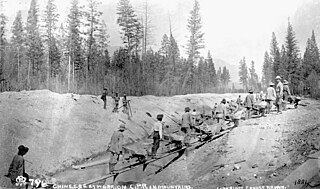Related Research Articles

Chinese immigrants began settling in Canada in the 1780s. The major periods of Chinese immigration would take place from 1858 to 1923 and 1947 to the present day, reflecting changes in the Canadian government's immigration policy.

Nanaimo is a city of about 100,000 on the east coast of Vancouver Island, in British Columbia, Canada. "The Harbour City" was previously known as the "Hub City", which was attributed to its original layout design with streets radiating from the shoreline like the spokes of a wagon wheel, and to its relatively central location on Vancouver Island. Nanaimo is the headquarters of the Regional District of Nanaimo.

Saysutshun Provincial Park, formally known as Newcastle Island Marine Provincial Park, is a provincial park located on a small island off the coast of Nanaimo, British Columbia, Canada.

The Island Corridor, previously the Esquimalt & Nanaimo Railway, is a railway operation on Vancouver Island. It is owned by the Island Corridor Foundation, a registered charity. The railway line is 225 kilometres (140 mi) in length from Victoria to Courtenay, known as the Victoria Subdivision, with a branch line from Parksville to Port Alberni, known as the Port Alberni Subdivision, of 64 kilometres (40 mi), for a total 289 kilometres (180 mi) of mainline track. In 2006, the Island Corridor Foundation acquired the railway's ownership from RailAmerica and Canadian Pacific Railway.

Duncan is a city on southern Vancouver Island in British Columbia, Canada. It is the smallest city by area in Canada. It was incorporated in 1912.

The Nanaimo mine explosion occurred on May 3, 1887, in Nanaimo, British Columbia killing 150 miners. Only seven miners survived and the mine burned for one full day.

Robert Dunsmuir was a Scottish-born Canadian businessman and politician.

Cumberland is an incorporated village municipality east of Perseverance Creek, near the east coast of central Vancouver Island, British Columbia. The Comox Valley community is west of BC Highway 19 and is by road about 105 kilometres (65 mi) northwest of Nanaimo and 10 kilometres (6 mi) southwest of Courtenay.

The history of Vancouver, British Columbia, is one that extends back thousands of years, with its first inhabitants arriving in the area following the Last Glacial Period. With its location on the western coast of Canada near the mouth of the Fraser River and on the waterways of the Strait of Georgia, Howe Sound, Burrard Inlet, and their tributaries, Vancouver has – for thousands of years – been a place of meeting, trade, and settlement.

CKWV-FM is a Canadian radio station located in Nanaimo, British Columbia. It broadcasts on 102.3 FM and is owned by Island Radio, a division of the Jim Pattison Group.

The Chinatown in Victoria, British Columbia is the oldest Chinatown in Canada and the second oldest in North America after San Francisco. Victoria's Chinatown had its beginnings in the mid-nineteenth century in the mass influx of miners from California to what is now British Columbia in 1858. It remains an actively inhabited place and continues to be popular with residents and visitors, many of whom are Chinese-Canadians. Victoria's Chinatown is now surrounded by cultural, entertainment venues as well as being a venue itself. Chinatown is now conveniently just minutes away from other sites of interests such as the Save-On-Foods Memorial Centre, Bay Centre, Empress Hotel, Market Square, and others.
The Chinese Consolidated Benevolent Association (CCBA) is a historical Chinese association established in various parts of the United States and Canada with large Chinese communities. The association's clientele were Chinese immigrants of the late 19th and early 20th centuries, mainly from eight districts on the west side of the Pearl River Delta in Guangdong, southern China, and their descendants. The later wave of Chinese immigrants, after 1965, who came from a much wider area in China, did not experience the level of hostility faced by the pioneers and did not join the CCBA, which greatly lessened its influence.
Wellington, formerly a separate district and town, is a neighbourhood of north Nanaimo, on the east coast of southern Vancouver Island, British Columbia.
The Wellington station located in the Wellington area of Nanaimo, British Columbia, was a flag stop on Via Rail's Dayliner service, which ended in 2011. The station is on the Southern Railway of Vancouver Island mainline. The station was named after the town of Wellington which formed around and next to the Wellington Colliery which was named after Arthur Wellesley, 1st Duke of Wellington, a leading British military and political figure in the 19th century.
Chinatowns in Canada generally exist in the large cities of Vancouver, Ottawa, Calgary, Edmonton, Toronto, and Montreal, and existed in some smaller towns throughout the history of Canada. Prior to 1900, almost all Chinese were located in British Columbia, but have spread throughout Canada thereafter. From 1923 to 1967, immigration from China was suspended due to exclusion laws. In 1997, the handover of Hong Kong to China caused many from there to flee to Canada due to uncertainties. Canada had about 25 Chinatowns across the country between the 1930s to 1940s, some of which have ceased to exist.
Windsor's West Side neighbourhood is home to a Chinatown. As of 2012 it is the largest Chinatown in proximity to Detroit, Michigan.
Extension is an unincorporated community near the east coast of southern Vancouver Island, British Columbia. The location off BC Highway 19 is about 107 kilometres (66 mi) by road northwest of Victoria, and 10 kilometres (6 mi) south of Nanaimo.
The history of Chinese Canadians in British Columbia began with the first recorded visit by Chinese people to North America in 1788. Some 30–40 men were employed as shipwrights at Nootka Sound in what is now British Columbia, to build the first European-type vessel in the Pacific Northwest, named the North West America. Large-scale immigration of Chinese began seventy years later with the advent of the Fraser Canyon Gold Rush of 1858. During the gold rush, settlements of Chinese grew in Victoria and New Westminster and the "capital of the Cariboo" Barkerville and numerous other towns, as well as throughout the colony's interior, where many communities were dominantly Chinese. In the 1880s, Chinese labour was contracted to build the Canadian Pacific Railway. Following this, many Chinese began to move eastward, establishing Chinatowns in several of the larger Canadian cities.
Lynne Bowen is a Canadian non-fiction writer, historian, professor, and journalist, best known for her popular historical books about Vancouver Island and British Columbia. Over the years, Bowen has won awards such as the Eaton's British Columbia Book Award (1983), the Lieutenant Governor's Medal for Writing British Columbia History (1987), and the Hubert Evans Non-Fiction Prize (1993).
References
- 1 2 3 4 "Introduction Archived 2016-03-04 at the Wayback Machine " (Archive). Nanaimo Chinatowns Project, Malaspina University-College. Retrieved on February 15, 2015.
- 1 2 3 4 5 Willmott, W.E. "Some aspects of Chinese communities in British Columbia Towns" (Archive). BC Studies . No. 1. (Winter 1968-1969). p. 27-36. See profile. -- CITED: p. 33.
- 1 2 3 4 5 6 "Chinese Community" (Archive). Vancouver Island University. Retrieved on February 15, 2015.
- 1 2 3 4 5 6 Lai, David Chuenyan. Chinatowns: Towns within Cities in Canada. UBC Press, October 1, 2007. ISBN 0774844183, 9780774844185. p. 39.
- ↑ Lai, David Chuenyan. Chinatowns: Towns within Cities in Canada. UBC Press, October 1, 2007. ISBN 0774844183, 9780774844185. p. 45.
- ↑ Lai, David Chuenyan. Chinatowns: Towns within Cities in Canada. UBC Press, October 1, 2007. ISBN 0774844183, 9780774844185. p. 73.
- 1 2 Lai, David Chuenyan. Chinatowns: Towns within Cities in Canada. UBC Press, October 1, 2007. ISBN 0774844183, 9780774844185. p. 77.